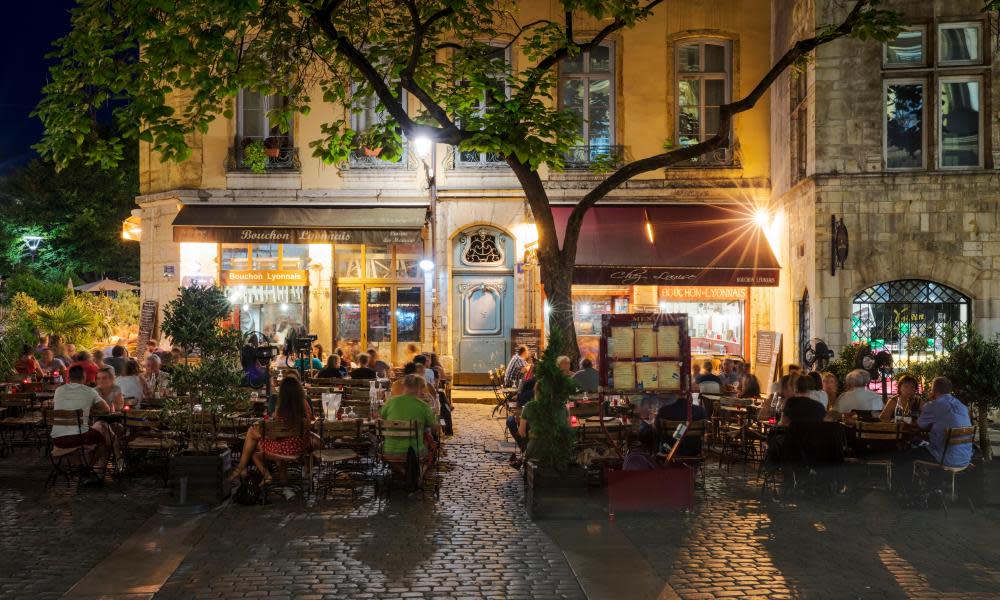Dirt by Bill Buford review – how to cook like a French chef

When he was merely middle-aged, Bill Buford quit as the fiction editor of the New Yorker to learn to become an Italian chef. That was a decade and a half ago. His progress and misadventures in New York kitchens and Tuscany were recorded in Heat. Now, older but absolutely no wiser, he decides on a whim to run away to France, where he’ll learn to become a French chef. He drags along his wife, Jessica Green, and twin sons, George and Frederick, who are a congenial presence in this artfully artless chronicle of cheffery, chef lore, chef “philosophy”, chef boorishness, chef hierarchies and chef cultishness. Buford is bullied, victimised and mocked by kitchen sociopaths half his age. What on earth propels him? There is evidently a sort of man-of-action masochism at play. The more hurtful the better. Niceness doesn’t make good copy.
A patsy, a chaotic, gaffe-prone near-loser who just about muddles through: that is how he casts himself and it’s the role he elects to perform much of the time. The Buford of Dirt shares a name with the sassy publishing operator he once was: a name, and not much else. He has a wide-eyed unknowingness and is happy to agree that in the wildflower-obsessed Michel Bras’s cooking there is an essence that “seems to radiate almost spiritually”.
Buford not only listens to chef Anne Sophie Pic declaring that her cooking is “the food of emotion”, he compounds this hyperbole with the qualification that “the emotions expressed in it must be many: longing, sadness, tenderness, loss. There is also rage. A rage against mortality. A rage against injustice.” To sample this rage, and much else besides, on a “sensory journey in 10 stages” costs €320 per head without wine.
Buford’s immersion is largely in a rarefied world of high craft, one concerned with “paintings on a plate”, recondite flavours and ingredients touched by dozens of fingers. This is the world of the tyrannical Michelin guide and of aspirants to its stellar approbation. Many aspire, few achieve: and those who do are often bankrupted by the effort to keep up the appearances that Michelin demands.
It is explained to Buford that one cook, Sylvain, “is not good enough”; he “is a bistro chef”. Sylvain has proved to be a thoroughly unpleasant piece of work, a bullied boy who has turned into a bully himself. He had relentlessly antagonised Buford. The writer has a humanity and decency that are seldom to be found in the quasi-martial milieu of the kitchen ruled by punishments and omerta. So he sympathises. Sylvain “had the manner of a man betrayed: not just by the restaurant but by the culture of the kitchen, by France”.
It is a given that a bistro chef inhabits a lower rung of the hierarchical ladder than a gastronomic chef. Amazingly, bistro chefs accept this and give forelock to the “superior” breed, with its full apparatus of chefbiz: marketing, PR, gimmicks, restaurants all over the world, awestruck food “writers” such as Ruth Reichl and wearisome “molecular” cuisiniers like Marc Veyrat, another wildflower obsessive with a sideline in bark, who demonstrates just how characterful he is by wearing black capes and hats like a panto villain, and who, on a visit to New York, “forages” in Central Park. What daring!
The stage for all this chefolatry is Lyon; deemed by the writer Curnonsky in the 1930s to be gastronomic capital of France, and thus of the world. Buford describes it as a “seldom visited beautiful gem of a city”. That “seldom visited” is puzzling because it has for many decades been a cynosure of the gastronomically curious and the very greedy, a pilgrimage site for the global stomach. Standards are very high.
Buford is a persuasive advocate for the rough edges of what was his adopted home. He still longs for its “gritty darkness, the sewage smells, the graffiti, the cobblestone streets ... its low cloud of melancholy”. His affection for the everyday details and specificities of the place is attractive. But it is, strangely, not matched by an enthusiasm for the vernacular cooking of the city.
Related: ‘At 3am in Bob's boulangerie, you could peel the yeast off the wall…’
Most of the dishes he painstakingly masters belong to the repertoire of haute cuisine, which while it may have its foundations in a particular locus, is international – think of those empire-building, jet-lagged chefs with concessions and brigades in Oman, Hong Kong, Miami, London, Rio. The vernacular should be in a state of perpetual stasis, thrilling in its immutability. At Georges Blanc’s marvellous Ancienne Auberge in Vonnas, the dishes are those made by his grandmother. They are not adapted, not given a wretched “twist”. The cooking of the Lyonnaises mères was a collective marvel: despite being the wrong gender, Paul Bocuse was the last and greatest of them. Although Buford is fascinated by chicken cooked in a pig’s bladder and details the preparation with gusto, he is not keen on tripe, assorted innards and extremities – which can be a problem in a city devoted to their ingestion. Here is a gastro instance of the broader culture clash that informs much of his life in the city.
For the Lyonnais/New York chef Daniel Boulud, who opened many doors for Buford, Lyon is a “time-warp city”, which accords with Bertrand Tavernier’s neat aphorism “the last time I saw Paris it was in Lyon”. Lyon is what France was an indefinite time ago: Buford is lucky to have lived there then. He has written a report from that past.
• Dirt: Adventures in French Cooking by Bill Buford is published by Jonathan Cape (£18.99). To order a copy go to guardianbookshop.com. Free UK p&p over £15


